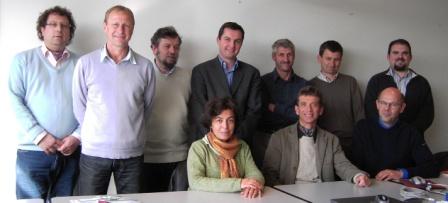COMIFER Liming Group brings together some twenty active members and as many associate members interested in the issue of liming. They come from very different backgrounds, INRA, technical institutes, education, chambers of agriculture, soil analysis laboratories, manufacturing companies and amendment distributors.

This group is led by Bruno FELIX-FAURE (GALYS) and Jean-François STEINMANN (AGRI AVENIR Val de Noye) that ensure the secretariat.
The group meets 4-5 times a year.
 Some members of the working group
Some members of the working group
The Liming COMIFER group has set the following objectives:
- To be a forum for discussion and exchange,
- Collect existing references on liming,
- To initiate the necessary research,
- To establish as broadly and as consensually as possible the necessary elements for sustainability and the practice of liming,
- Prepare their outreach to all industry players
 We have four main issues of concern:
We have four main issues of concern:
- Understanding the mechanisms of action of amendments in soils
- Establish references on the acid-base status desirable for crop systems
- Propose an approach for assessing the need for the amendment and propose it to software developers,
- Prepare a study on the choice of products.
We can divide the activity of the group into two phases
In the 80s, a resumption of gains that resulted in the production of the book: The Lime State of Soil and Fertility: Liming, edited by COMIFER. At the time, the group was called Calcium, Magnesium and Trace Element Amendments.
Then in the 90s, the group conducted a second study to clarify the following points:
Understanding the action mechanisms of basic calcium amendments.
This was the group’s first task. It resulted in the publication of a glossary and a text “Essential Questions on Liming” (2000). We emphasize the fact that it is the anion accompanying the calcium that can raise the pH and increase the CEC. In relation to the physical aspects of the soil, we have been initiators of a new work on the role of liming, relayed by the Soil Science laboratory of INRA Versailles. These approaches have resulted in various publications at the Academy of Agriculture (February 2000) the acidification symposium of INRA Versailles (April 20001), to the Gemas Comifer Congress in Blois (1995, 2001). This maturation led to proposed changes in the AFNOR standards on classifications of products.
Establish benchmarks
The analysis tests conducted on liming show that performance is not the best indicator of the expected gains because liming plays on the crop conditions, in close interaction with the other factors of production. We propose to conduct further trials with a protocol that is similar to the tests performed on crops. The group is built on the basis of new tests on the acid-base status of meadows. The same thinking must be refined and completed for Arable Farming Systems (see Gemas 95).
Propose an approach for assessing the need for amendments.
The group worked on the calculation of basic needs. The forms are available in the liming brochure.
A – Glossary of liming
To view this document click here
B – Essential questions on liming
This text summarizes the main achievements of the COMIFER Liming Group. It is the result of a collaboration of varied skills, from those of chemists to those of agronomists.
To view this document click here
C – Letter to soil test laboratories
Newsletter to soil analysis laboratories.
To view this document click here
D – List of published references
Reference document groupings COMIFER group publications and external publications.
To view this document click here
E – Press sheets from the INRA Conference on Liming of April 2001
Why lime ponds?
Text by B. BACHASSON
Higher Education in Forestry and Aquaculture
Agricultural High School of Poisy-Annecy
74330 Poisy.
To view this document click here
Aluminium Toxicity:
major acidity risk
in agricultural soils
Text by A. BOUTHIER
ITCF, Experimental Station of MAGNERAUD
17700 Saint Pierre d’Amilly.
abouthier@itcf.fr
and of P.CASTILLON
ITCF , Inter-institute station of BAZIEGE
6 chemin de la côte vieille – 31450 Baziège.
pcastillon@itcf.fr
To view this document click here
Liming in cultivated soils:
importance of buffering capacity
Text by N.DAMAY et J-L. JULIEN
Agronomic Station of l’Aisne
rue Fernand Christ – 02007 LAON CEDEX
Tel: 03 23 23 64 70 – Fax: 03 23 23 64 99
ndamay@cg02.fr
jljulien@cg02.fr
To view this document click here
The overliming of soil:
impact on the pH and the release of the elements calcium and magnesium
J.P. DELHAYE. Director of the Plant Agro-technologies Laboratory (CP 169)
Inter-faculty Section of Agronomy
Free University of Bruxelles
50 av. F.D. Roosevelt – 1050 Bruxelles
O. BERNARD
Aumale Synergies
Lhoist France, rue de Rivoli 168- 75 038 Paris cedex 01
To view this document click here
Risk assessment of metal contaminated soils depending on acidity
S. DUPUY
Engineer in charge of studies at the Department of Engineering and Consulting of l’IEEB
1, rue Professeur Vèzes – 33300 BORDEAUX
Tel : 05 56 01 84 29 – Fax :06 72 76 50 76
To view this document click here
Acidification of soils and bioavailability of trace elements
Text by G. Echevarria, J. L. Morel, T. Sterckeman, S. Massoura and E. Gérard, based on the work of Soil and Environment Laboratory UMR INRA – ENSAIA/INPL de Nancy.
To view this document click here
The practice of liming:
Advice at the farming level
Text by B. FABRE
ISARA
31 place Bellecour – 69288 LYON
fabre@iasara.fr
and by F. KOCKMANN
CA 71
59 rue du 19 mars 1962 – BP 522 – 71010 MACON
To view this document click here
Product labeling
F-X. GAUMONT
Groupe MEAC S.A.S. (Amendements Minéraux Basiques)
BP 371 – 31 rue Nicole – 28007 CHARTRES Cedex
Tel: 02 37 20 24 24 – Fax: 02 37 20 24 59
francoisxavier.gaumont@meac.fr
To view this document click here
Lime sludge use in agriculture: better understanding their fertilizing value
Text by F. KOCKMANN
Chamber of Agriculture Saône-et-Loire
Tel. 03 85 29 55 74 – Fax: 03 85 29 56 77
ca71sage@voila.fr
To view this document click here
Changing physical properties under the influence of liming: Case Trial GAME-LES-BOIS (36)
Collective Study by :
C. LE SOUDER – ITCF – 91720 BOIGNEVILLE
Y. DUVAL – INRA Agronomy – 02000 LAON
Y. LE BISSONNAIS – INRA-SESCPF – 45160 ARDON
G. RICHARD – INRA Agronomy – 02000 LAON
C. DURR – INRA Agronomy – 02000 LAON
D. TESSIER – INRA Soil Science – 78000 VERSAILLES
J-L. JULIEN – SAA – 02000 LAON
V. GARROS – COMIFER intern
A. PISSOT – INRA intern
With the participation of COMIFER – 8 av du Président Wilson – 75116 PARIS
To view this document click here
Characterization of basic amendments
Text by F. MARCOVECCHIO et J-L. JULIEN,
Agronomic Station of l’Aisne
rue Fernand Christ – 02007 LAON CEDEX
Tel: 03 23 23 64 70 – Fax: 03 23 23 64 99
fmarcovecchio@cg02.fr
jljulien@cg02.fr
To view this document click here
Experience of under forest amendments: assessment and prospects
Text by C. NYS
INRA Nancy – Biogéochimie des écosystèmes forestiers
54280 Champenoux
nys@nancy.inra.fr
by C. Richter
ONF STIR Nord-Est
and by J-P. Renaud
INRA Nancy
To view this document click here
Sustainable liming areas: influence on production and forage quality
Text by O. PELTIER
France Amendements – Agronomic Service
BP21 – 03800 GANNAT
Tel: 04 70 90 27 27 – Fax: 04 70 90 18 28
ol.peltier@wanadoo.fr
To view this document click here
Influence of fertilizers on soil’s physical properties: the case of 42 plots at INRA in Versailles
Text by A. PERNES-DEBUYSER and by D. TESSIER
INRA Versailles – Science of Soil
Route de St Cyr – 78026 Versailles
To view this document click here
Acidification of soil and effects of liming on forest plant biodiversity
Text by J-F. PICARD
INRA – Forest Ecology and Ecophysiology
54280 Champenoux
picard@nancy.inra.fr
by C. Richter
ONF STIR Nord-Est
and by J-P. Renaud
INRA Nancy
To view this document click here
The application practices when liming
Text by M. ROUSSELET
Cemagref de Clermont-Ferrand – Technology Unit, Information Systems and Processes for Agriculture and Agri-food
To view this document click here
Rehabilitation of aquatic environments by carbonate amendments
Text written by J-B. SALINERES
European Institute of Environment of Bordeaux
1 rue du professeur VEZES – 33300 Bordeaux
To view this document click here
Influence of surface charges on the physical properties of soils
Text by D. TESSIER
INRA – Soil Science Unit
78026 Versailles
tessier@versailles.inra.fr
To view this document click here
The constituents of soil: meaning of the electrical surface charge
Text by L. CHARLET
Environmental Geochemistry Group – Université de grenoble I
CNRS – BP 53 – 38041 Grenoble
To view this document click here
Acidity and soil acidification; an introduction
Text by E. DAMBRINE
INRA Nancy Department of Forest and Natural Environment
54280 Champenoux
Dambrine@nancy.inra.fr
and D. Tessier
INRA Versailles
tessier@versailles.inra.fr
To view this document click here
Soil solution and ion exchange packing complex: evolution after acidification and liming
Text by J. DUFEY
UCL – Faculty of Agronomic Sciences
Croix du Sud 2 – 1348 Louvain-la-Neuve (Belgique)
http://www.agro.ucl.ac.be
To view this document click here
Proton flux in the rhizosphere and soil acidification
Text by B. JAILLARD
INRA – UMR Soil and Environment
place Pierre Viala – 34060 Montpellier cedex
Tel: 04.99.61.23.82 – Fax: 04.67.63.26.14
benoit.jaillard@ensam.inra.fr
To view this document click here
Impact of forest plantations treated semi-intensively on soil quality and the environment
Text by J. RANGER – based on work conducted on the Vauxrenard site by the Cycles biogéochimiques team of INRA Nancy : M. Colin-Belgrand (CR), J. Ranger (DR), Marie-P. Turpault (CR) ; A. Ezzaïm, J-H. Jussy, R. Marques (Doctorants), S. Villette (Ingénieur-ENESAD) ; M. François, O. Goedert (DEA) ; D. Gelhaye (TR), responsable du site ; S. Bienaimé [AI], P. Bonnaud [AI], L. Gelhaye [TR], B. Pollier [AI], analysts, as well as many temporary personnel (CES, CDD, Objecteur de conscience)
To view this document click here